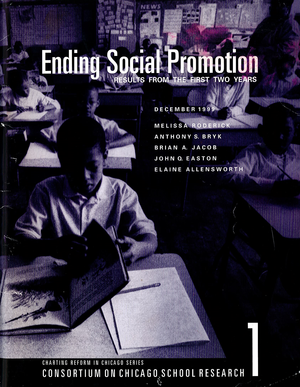Flows Through the Policy
1. Who was subject to the policy?
2. How many students made the test cutoff by May 1997?
3. What happened in the second year for those students who were retained in third and sixth grades?
4. What happened to eighth-graders who were retained or attended transition centers?
5. How did passing waiver, and retention rates change from 1997 to 1998?
Passing Rates and ITBS Achievements Trends Before and After the Policy
1. How many students were at risk under the policy?
2. Were more sixth-graders meeting the cutoff in 1997 than before the policy?
3. Did Summer Bridge raise the proportion of students who met the promotional cutoffs?
4. How many more students met the cutoff?
5. How did passing rates for third, sixth, and eighth grades in 1997 compare to 1995 rates?
6. To what extent were 1998 passing rates for third- and sixth-graders better?
7. What were the ITBS achievement trends among students who met the test criterian in May?
8. What were the ITBS achievement trends for sixth-graders in 1995 who were socially promoted?
9. Did Summer Bridge pay off?
10. How did retained and waived students progress?
11. What were the results for third-graders?
12. What were the dropout rates among eighth-graders in 1995 and 1997?
Ethnic and Gender Differences in Exclusion, Passing Waiver, and Retention Rates
1. How did ethnic Differences impact third-, sixth-, and eighth-graders under the policy?
2. Were there gender differences?
In 1996, the Chicago Public Schools implemented a policy designed to end social promotion and raise academic achievement. The centerpiece of this initiative is a set of promotional test-score cutoffs for third-, sixth-, and eighth-graders. Students in these grades must achieve a minimum score on the Iowa Tests of Basic Skills (ITBS) in reading and mathematics in order to be promoted to the next grade.
Students who do not meet the criteria are required to participate in a special summer school program, Summer Bridge, and retake the test at the end of the summer. Those who fail again are either retained in their grade, promoted nonetheless, or, if they are 15, sent to new alternative schools called Transition Centers. Because this policy's impact has been both far-reaching and controversial, the Consortium on School Research has embarked on a study to identify the ways in which it has affected student achievement and school instruction. This first report from the study compares the progress of students who faced the promotional test cutoffs in 1997 and 1998 with that of a group of students two years earlier, before the policy was in place. The main findings of this first report are the following:
- There have been impressive increases in the proportion of students who meet the test- score cutoff for promotions.
- The picture is mixed on whether getting students up to a test-score cutoff in one year allows them to do better the next year.
- Retained students continue to struggle.
- Overall results are much more positive for sixth and eighth graders than for third graders, suggesting that the policy might be more appropriate for older than younger grade levels.
- Administrative issues, such as decisions to exclude students or to promote them despite scores below cutoff, shape students' experiences under the policy.




